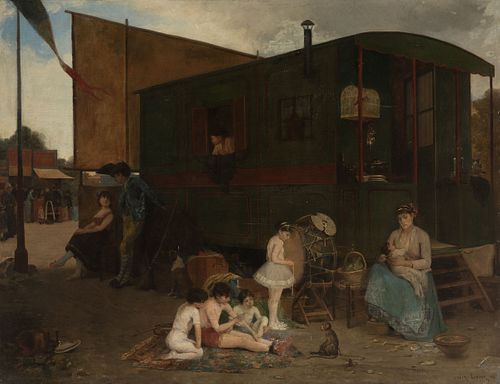URANIE ALPHONSINE COLIN LIBOUR (Paris, 1831- Paris, 1916). "Circus wagon", 1881. Oil on canvas.
Lot 69
About Seller
Setdart Auction House
Carrer Aragó 346
Barcelona
Spain
Setdart Subastas was born in 2004 and is currently the first online art auction in Spain with solidity, prestige and reliability guaranteed by our more than 60,000 users. Setdart has a young, dynamic and enterprising team ready to successfully manage the purchase and sale of art works through custom...Read more
Estimate:
EUR€8,000 - EUR€9,000
$8,602.15 - $9,677.42
Absentee vs Live bid
Two ways to bid:
- Leave a max absentee bid and the platform will bid on your behalf up to your maximum bid during the live auction.
- Bid live during the auction and your bids will be submitted real-time to the auctioneer.
Bid Increments
| Price | Bid Increment |
|---|---|
| EUR€0 | EUR€10 |
| EUR€200 | EUR€25 |
| EUR€500 | EUR€50 |
| EUR€1,000 | EUR€100 |
| EUR€3,000 | EUR€200 |
| EUR€5,000 | EUR€500 |
| EUR€10,000 | EUR€1,000 |
| EUR€20,000 | EUR€2,000 |
| EUR€50,000 | EUR€5,000 |
About Auction
By Setdart Auction House
Nov 10, 2021
Set Reminder
2021-11-10 08:00:00
2021-11-10 08:00:00
America/New_York
Bidsquare
Bidsquare : 19th & 20th Century paintings and Decorative Arts
https://www.bidsquare.com/auctions/setdart-auction-house/19th-20th-century-paintings-and-decorative-arts-7800
Setdart Auction House sofia@setdart.com
Setdart Auction House sofia@setdart.com
- Lot Description
URANIE ALPHONSINE COLIN LIBOUR (Paris, 1831- Paris, 1916). "Circus wagon", 1881. Oil on canvas. Signed and dated in the lower right corner. Measurements: 90 x 116,5 cm. The work introduces us between the backstage of a circus. The world of the circus, associated with an artistic, bohemian and free life, far from social conventions, and imbued with a special poetics, has been a common theme of contemporary and avant-garde artists. The artist uses, in this case, a realistic aesthetic technique, where color and pictorial matter compete with the precision of the drawing. The artist presents several characters, of different ages. Located next to a caravan, which the viewer interprets as property of the characters. These people are arranged on the sides of the scene, being the caravan, the object that occupies the central area of the composition. This generates a discourse around the itinerant life of the artist, who adopts a nomadic life in order to exercise his profession, added to the presence of several child characters that invite the viewer to reflect on the role of the child inserted in the bohemian life and its consequences. The aridity of the landscape presented by the artist does not cease to pose a somewhat tragic scenario of both the scene and the thematic discourse that generalizes the work. Uranie Alphonsine came from a noble family of Chartres who took refuge in Paris during the French Revolution and began her artistic training with her father, who was recognized for his work as a history painter. Later she continued her studies as a student of François Bonvin, Charles Müller and Sophie Rude. She exhibited at the Salon since 1861. He made several trips and participated in numerous exhibitions both nationally and internationally. An example of this is that his works could be seen in Madrid, Barcelona, Paris, at the Royal Academy in London in 1883. During his artistic career he also participated in the Universal Exhibitions of Paris in 1889 and 1900, as well as in the Chicago exhibition of 1893. Where she had the honor of being among the 170 French artists invited to exhibit in the Women's Building. In addition, in 1905, her painting La Charité was included in a book listing women painters of the world, The Women Painters of the World, published in London. Her work is characterized by an aesthetic based on precision and clarity of line, with a thoughtful choice of colors. Regarding the subject matter, she usually shows part of the misery and human anguish of modest people, the peasant world, and the working class.
- Shipping Info
-
In-house shipping available. Please inquire at admin@setdart.com.
-
- Buyer's Premium



 EUR
EUR CAD
CAD AUD
AUD GBP
GBP MXN
MXN HKD
HKD CNY
CNY MYR
MYR SEK
SEK SGD
SGD CHF
CHF THB
THB

















